|
Is
'noble wine' a valid concept?
A discussion by the members of the Academie Internationale du Vin (AIV)
London, 12 June 2012
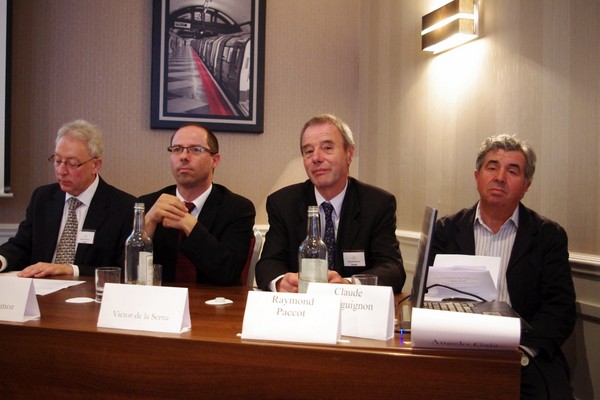
Some of the panel members: Michael
Schuster, Jose Vouillamoz, Raymond Paccot, Claude Bourguignon
On a Tuesday in June, in London, an
illustrious group of the great and the good of the wine world were
gathered to discuss whether or not ‘noble wine’ was a valid
concept. Some journalists, like me, were also invited. The meeting
was organized by the AIV, and, remarkably for a group with the term
‘international’ in their title, this was the first every meeting
they’d held that wasn’t conducted entirely in French.
The meeting was full of interest, but
there was one major fail: we were supposed to be discussing whether
or not the term ‘noble’ is a valid one when applied to wine, but
no one actually defined it. Of course, all the members of the AIV
are familiar with the term, because the founder of the AIV, Constant
Bourquin, spent a long time discussing and defining it back in the
1970s. Perhaps wrongly, the AIV assumed that everyone would be
familiar with Bourquin’s definition, and the centrality of this
concept to the AIV itself.
In his closing remarks, Michael Schuster
admitted this shortcoming. He’d actually instructed each of the
speakers to talk about what they thought the term ‘noble’
referred to when applied to wine. No one did. Still, there were some
very interesting presentations, made by a star-studded cast of
speakers. So here’s my summary.
Bruno
Prats - nobility and history
Prats began by saying that it was ironic
that the concept of noble wine should be invented by the founder of
the AIV who was Swiss, and the Swiss got rid of their nobility
several centuries ago, while the Brits seem to have more of a
problem with the term ‘noble wine’, even though we kept our
nobility.
He described how the classified growths
of the Médoc
in Bordeaux were created by nobility: members of the parliament of
Bordeaux, who he described as ‘an enlightened and enterprising
nobility.’ In France, noble status prohibited one from being
involved in trade and industry, but not agriculture.
The creation of Haut Brion as a wine
estate in 1533 was the first sign of a new move in viticulture: the
creation of estate wines. Of course, Burgundy had already designated
wines on the basis of terroir, but Bordeaux named the producer.
The cru classés were owned
by nobles, who built Châteaux,
with Prats remarking that the French have a bit of an obsession with
Châteaux.
He pointed out, however, that in the 1855 classification of the Médoc,
only 5 of the classed growths were called ‘Château’.
This term was awarded as a sign of the nobility of wines, but has
become abused, and even applied to Cru Bourgeois, ‘the opposite of
nobility’.
Noble wines can grant nobility to those
who own them, says Prats. Today, there is a constant search for
extreme quality without consideration for cost, and in this the
classed growths of the Médoc
are the archetype of noble wines. He added that it is much more in
the spirit of the foundations of the classed growths for them to be
in the hands of families, and the real spirit is for them to be
owned by a single person.
My
comment? I didn’t really see what point Prats was trying to make,
other than that the aristocracy of France, noble by birth,
established the leading Bordeaux classed growths. Is he suggesting
that nobility is somehow conferred on wines by their historical
association with the aristocracy? Does he believe that some people
are more noble than others because of their birth right and that
this is conferred to the products of any vineyards they own?
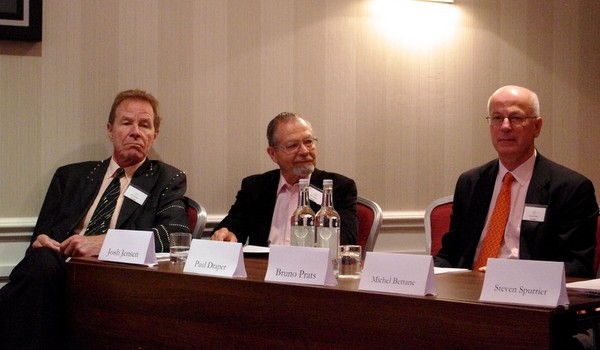
Josh
Jensen, Paul Draper and Bruno Prats
Michel
Bettane – the nobility of French terroirs
‘I will try to avoid any arrogance
while discussing this topic,’ began Michel Bettane, one of the
smartest of all wine journalists, but not widely celebrated for his
humility. ‘Terroir is a French word used almost everywhere without
a precise idea,’ he stated. ‘In France, its meaning for a long
time was not particularly positive.’ He explained how a terroir
taste referred to an earthy flavour associated with second-rate
origins. Likeable but not fine. ‘Wine with a terroir taste is
supposed to be born in a second-rate vineyard.’
Great Bordeaux wines were described not
by their taste but by their behaviour, with metaphors used to liken
them to fine human beings. In Burgundy it was just the slightly
second-rate appellations, such as Pommard, that were described as
earthy. If Champagnes weren’t good, they could be identified by
their soils.
Bettane seemed to be against the idea
that the nobility of wines lies just in the soil that they come
from. It is knowledge and ability that give nobility to wine. The
work of humans brings many changes to the original soil by
cultivation.
If by terroir we mean places where
viticulture is undertaken, then the French are lucky enough to have
the widest diversity of terroirs, asserts Bettane. But do they
deserve it? He says that in the second half of the 19th century the
level of soil cultivation in the most famous French vineyards was
the highest in the world. France was the most visited country by
rich foreigners, and wine was part of the appeal. Many generations
of sophisticated upper class people created the renown for the best
French wines that laid the foundations of wine civilization.
But then came phylloxera, and the
difficult years of the early 20th century, which created many
changes of ownership of the vineyards. The new owners didn’t
always appreciate what they had. Grapes became of lesser quality
because of bad farming, necessitating the adoption of winemaking
technology to make up for this.
As a consequence, the new wines of the
new world were often better than the French wines. This was shown in
blind tastings such as the judgment of Paris. France was no longer
the number one wine country.
However, for the last 15 years a lot of
work has restored France to pole position, as the number one wine
producing country in the world. ‘I am deeply convinced that France
is back in its prime position because France has its natural
priveleges,’ says Bettane. ‘There has never been such a wide
choice of wines in France. This is difficult to find anywhere else
in the world.’
My
comment? Michel’s talk was of real interest, but I couldn’t help
feeling that he’s just a little too Francocentric. France makes
some great wines, but so does Italy. So does Spain, so does Portugal
– I could go on. There are many great terroirs worldwide, and many
of these have only fairly recently been discovered. Winemaking
developments have enabled winegrowers to unlock terroirs that were
previously obscured by bad winemaking. The economic returns on fine
wines—and the fact that the fine wine world is no longer stuck in
a Francocentric rut—now makes it possible for people to invest in
making great wines from great terroirs that weren’t made in the
past. Interestingly, in the question
session that followed his talk, Michel commented that it was
‘the human factor that creates nobility’ in wine. He stated that
Grand Cru is in the heads of the drinkers, suggesting that what is
regarded as a great wine is in part a human construct. This could
lead to a very interesting discussion of aesthetics. What makes a
wine great? It’s certainly a partnership between the terroir, the
wine grower, and the aesthetic system of wine appraisal.

Victor
de la Serna
Victor
de la Serna - noble wine and terroir in Spain, not always eye to eye
Because there was a delay loading his
powerpoint presentation, Victor de la Serna had time at the
beginning to go off-piste and actually explain a little about the
original AIV definition of a noble wine. It’s a wine that is
naturally made, from good terroirs, with the ability to age well.
This brief stab at a definition was the only one made by any of the
speakers.
Victor is one of Spain’s top wine
journalists, and also has a day job as a proper journalist, as well
as making some very smart wines from his own vineyard. Victor
explained how Spain is blessed with great terroirs. It has the
largest surface area of limestone-based vineyards in the world (this
was disputed later by Claude Boruguignon and Michel Bettane, but I
fear Victor may be right), frequently at altitude, and also has lots
of old vineyards. The amazing longevity of the greatest Rioja
wines—sometimes even more than great Bordeaux—is proof that they
come from great terroirs, he asserts.
Victor’s talk focused on the only two
Spanish regions with centuries of tradition of fine wine: Jerez and
Rioja. Vines arrived in the south of Spain in 1100 BC with the
Phoenicians, and later Columella spotted the good (albariza) and bad
(sandy) terroirs in Jerez. However, the Jerez terroir concept has
been severely diminished over the last 40 years because of the
collapse in sherry production. This has led to the widespread
adoption of technology to bring costs down, which has diminished the
terroir effect.
Most firms should follow the lead of
Valdespino, says de la Serna, who have their own vineyards and
vinify in oak casks, without using selected yeasts.
He cites Lopez de Heredia as showing an
example of how Rioja should go. They source all their wines from
their portfolio of four vineyards, including the 100 hectare Viña Tondonia vineyard. There are also small
artisinal producers who are making wines from proscribed vineyards.
The Rioja appellation has long resisted the classification of
vineyards, and many top wines are sourced from varying sources
depending on the vintage.
Telmo Rodriguez’ Remelluri estate in
Rioja has started making wines with the location of the vineyard
sources on the label: La Bastida and San Vicente de la Sonsierra. He
has had a hard time encouraging authorities to consider the village
concept, and although he is allowed to identify the village names on
the labels, this is not a legal statement in that he doesn’t have
to have a correspondence between what is on the label and where the
grapes came from. Real vineyard or simple brand? You need to trust
the producer.
De la Serna then went on to describe how
Priorat now has Spain’s first Burgundy-style village appellation.
Victor finished by saying that it is a
tragedy that the two greatest winemaking regions of Spain are known
mostly for their winemaking practices. Winemakers his age (he’s in
his mid 60s) love technical paraphernalia, but winemakers in their
30s know about technology yet are going back to the vineyard.
My
comment: I thought Victor did a really good job in describing the
tension between the genuine terroir wines of Spain, and the perhaps
more celebrated wines that have a greater imprint of the winemaking
process. For me, he is one of the Spanish critics I listen to most
closely.

Paul
Draper of Ridge, one of California's most respected wineries
Paul
Draper –noble wine: a California perspective
Paul Draper began by stating that he
preferred to use ‘wines of place’ to the term ‘noble wines.’
So what does this mean? The first duty of wine is to give pleasure.
For some wines, it is justified to give the grapes a lot of help in
the cellar. Over 90% of the world’s wines are industrial, and it
is necessary to create these wines in the cellar. But such intrusive
processing isn’t appropriate for wines being sold for a lot of
money.
In the vineyard, whether you work
organically, biodynamically, or conventionally, you have a box
within which you work. In the cellar there are no such limitations.
Most winemakers are unwilling to discuss where they stand on the
slippery slope of industrial winemaking.
California has a fairly benign climate
where there isn’t much rain from May to harvest. So in the
vineyards there is a much better chance of using organic or
sustainable techniques. An exception would be the 2011 vintage which
was the most disastrous in 50 years in some places.
In the cellar in California it is a very
different story. The term ‘winemaker’ convinces people that it
is their job to create the style of wines. There are concentrates,
reverse osmosis and other tools to create style. In recent years
California has seen a lot of consensus winemaking: people look at
what their successful colleagues are making and then try to make
their wines in the same style. It is hard to tell the wines apart.
‘I hope we move away from fruit
bombs,’ says Draper. ‘In the late 19th century and the first
half of the 20th, people were much closer to the vineyard and took
much more natural approaches in the cellar than they do today.’
He added that a fine wine of place needed
to be true, which necessitates the use of at least the minimum dose
of sulfur dioxide. Too little, and the wine won’t show a sense of
place and won’t age.
Most winemakers are still taught that a
chemical toolkit is needed and processing is essential for making
wine. But there are now a number of producers who are deliberately
allowing the sense of place to show.
My
comment: I thought Draper was spot on. The exciting bit of
California’s wine scene seems to be moving in a direction of
working more naturally, expressing terroirs more clearly, and
backing off from over-ripeness and too much intervention.
Interestingly, he described later how his grounding in wine included
tasting many great old bottles of Bordeaux. He was thrilled by the
fact that he could recognize the characters of specific terroirs and
Châteaux
and properties in the wine. This is now getting quite difficult.
Bordeaux seems to have been moving in the opposite direction to
California, with increasing ripeness and more intervention. It is
perhaps less interesting and noble now than it used to be, even
though the wines are now fetching higher prices.
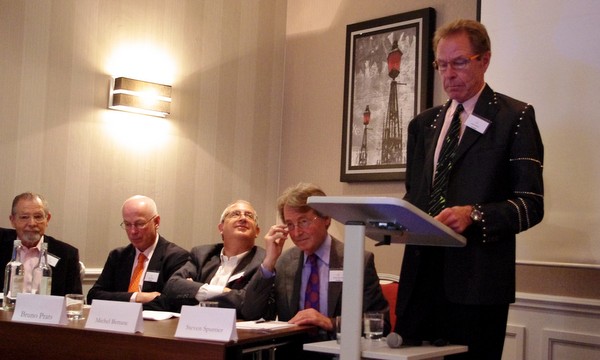
Josh
Jensen, watched by Draper, Prats, Bettane and Spurrier
Josh
Jensen – terroirs new and old
Josh Jensen began by saying how there’s
next to no limestone in California: he knows, because before
planting Calera Vineyard he spent two and a quarter years looking
for it. The other Californian growers who have limestone are Ridge,
Tablas Creek and Chalone. ‘The wonderful concept of terroir should
be an inspiration to all grape growers and wine lovers,’ he
stated.
In addition to the usual influences of
terroir he pointed out that California has its own aromatic inputs
from native bushes such as wild lilac and California buck eye, as
well as introduced species such as eucalypts and lavender. The
aromatic oils can flavour the wine.
Jensen also added that a discussion on
terroir is not complete without including the indigenous yeast in
the vineyard. The almost standard practice of killing wild yeast by
adding SO2 to grapes at reception is a bad idea.
Every site is a terroir. Many continental
and Mediterranean European terroirs date to antiquity.
Classifications have been proposed and codified. Now many of these
sites are considered legendary. What about new sites planted 50
years ago? ‘My first three vineyards were planted 37 years ago,’
says Josh. ‘Each of these vineyards was planted in land never
previously farmed. It is undeniably a unique terroir.’ But can
such young terroirs be considered great? Or very good? Or even
merely good? It is probably too early to make a judgement. New
Zealand and Chile have a preponderance of vineyards planted since,
say, 1950. ‘Each person gets to make up their own mind,’
concludes Josh.
My comment: Josh is really smart, and the
way he fielded a question by Anthony Rose demonstrated this. Anthony
suggested that the fact that Eduardo Chadwick’s Seña wine recently beat some stellar first
growth Bordeaux in a blind tasting proves that Seña is a noble wine.
Josh straight batted the question, suggesting that this is not a
logical conclusion in the most diplomatic way possible.
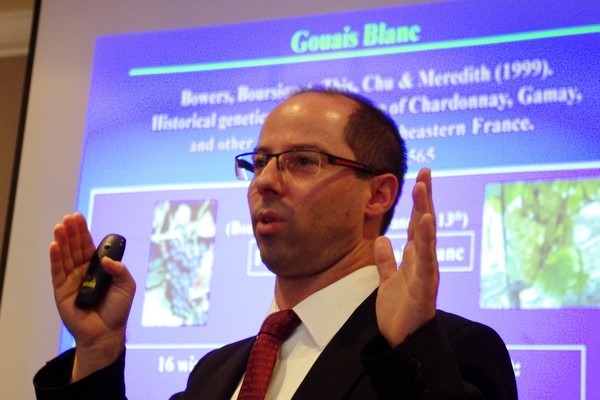
Jose
Vouillamoz, viticulture researcher
José
Vouillamoz - the concept of the noble grape variety
In his talk, José Vouillamoz
addressed the concept of noble and common (or vulgar) grape
varieties, and whether such a notion makes any sense.
Each grape variety starts off as a seed,
but to keep the interesting features of the variety it must be
propagated vegetatively, by taking cuttings. If this is done for
1000–2000 years, there is an accumulation of mutations. Some of
these have no visual effect, while others are spectacular, such as a
change of colour. Each time we identify a difference and propogate
from that plant, we have a clone.
Interestingly, while Pinot Noir, Gris and
Blanc are regarded as separate varieties, they aren’t. They are
technically clones of the same variety, which has had some accidents
along the way.
José showed some examples of classifications
of noble and common varieties. They are all very European-centric,
with no reference, for example, to Georgian varieties. And the same
varieties are frequently classified differently.
The concept of noble varieties is a bit
silly. In 1997 the parentage of Cabernet Sauvignon was discovered to
be Cabernet Franc and Sauvignon Blanc, which clearly wasn’t a
deliberate crossing. A lot of grape varieties are linked together.
Carmenere’s parents are Cabernet Franc and Gros Cabernet. And
Gouais Blanc, which has been grown all over Europe, has produced
many ‘noble’ varieties, acting as a parent to Chardonnay,
Riesling, Furmint and Blaufrankisch, among others. Yet Gouais is
considered to be a low quality grape; a weed. People used to plant
it around the perimeters of their vineyards to deter grape thieves.
It has been said that noble varieties
keep their character when they move. But Sangiovese, Tempranillo,
Furmint and Nebbiolo don’t travel well. It has also been said that
noble varieties have low yields, but this isn’t true: Syrah, for
example, has some high-yielding clones.
My
comment: José's presentation was brilliantly done, and was perhaps
the best received of the whole session. The strength of it was that
it was data-focused. Here was something concrete to discuss, rather
than just vague notions. It was also nice to get a very quick peep
at the forthcoming grape variety book, authored by Vouillamoz,
Harding and Robinson, which looks set to be quite a publication.
Raymond
Paccot - biodynamics and noble wines
Raymond Paccot introduced the subject of
biodynamics before handing over to Claude Bourguignon. He described
this way of farming and noted that the 20th century saw the arrival of new cultivation methods, some good, some bad. Both
terroir and vineyard suffered damage from herbicides and
water-soluble fertilizers. ‘Polluted soils can’t breathe any
more,’ says Paccot. ‘Soils like this can’t produce the best
grapes.’ The result of biodynamics, he claims, is noble wine,
reflecting the personality of the place where the grapes grow.
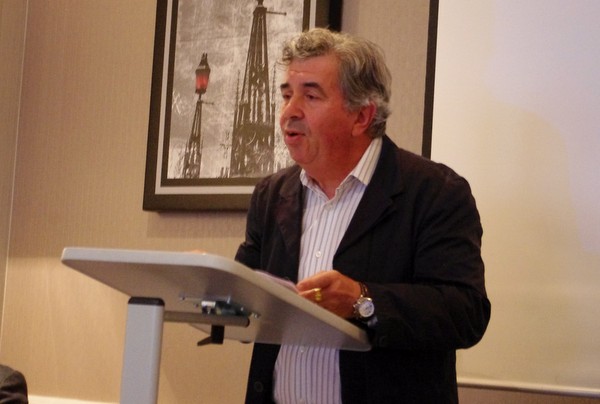
Claude
Bourguignon,
soil expert
Claude
Bourguignon – biodynamics and noble wines
‘It is the scientists job not to make
judgements, but to observe and make measurements,’ began Claude
Bourguignon, neatly sidestepping any need to comment on the
mechanistic assertions of biodynamics, which are problematic for
scientists.
His interest is in the soil, and the life
it contains. Interestingly, Bourguignon pointed out that he
sometimes sees more biological life in the top soil of
conventionally managed vineyards than biodynamic ones, where the
conventional growers have been using organic matter to improve the
soil. But the differences lie further down.
We always see deeper roots with
biodynamics, says Bourguignon. He sees more micronutrients available
in the deep soil, and more microbiological activity. All the
compounds produced in a living system are produced by enzymes, he
points out. And these enzymes have metallic co-factors, such as
magnesium in chlorophyll. Micronutrients such as this all come from
the soil.
He adds that we still don’t know all
the enzyme pathways involved in the synthesis of aroma compounds or
their precursors. Hydroponically produced fruits have no taste, he
says. If there are no soil microbes there are no micronutrients and
thus no aroma, because enzymes need these micronutrients as
cofactors.
He gave examples of Morgon, which is
grown on soils rich in manganese, and Brouilly, grown in soils rich
in zinc. These levels are elevated in the grapes, and can result in
differences in the wines.
Vine root growth reduced from 3.5 m to
0.5 m in one century, asserts Bourguignon. But this can be reversed
by the use of biodynamics. When you stop using herbicides, life
reacts quickly, and root growth of 20 cm can be seen in a year.
Herbicides reduce the fauna because the fauna has nothing to eat.
My
comment: Bourguignon makes some brave statements that can be forged
into a testable hypothesis. He is suggesting that the limiting
factor in the aromatic expression of many wines is trace elements
that act as enzyme co-factors in aroma (or aroma precursor –
because most aromas are formed by yeasts during fermentation)
synthesis. This is testable, but I think he presents too simplistic
a picture. Co-factors are needed not only for enzymes involved in
aroma precursor and aroma synthesis, but also for the growth of the
vine. Their absence or deficiency would impact on vine growth quite
significantly.
Microbes
in the soil interact with the vine in many and complex ways. It
would be interesting to compare the benefit of avoiding herbicide
use altogether in conventional viticulture with using herbicides
just under the row, with various cover crop regimes, and seeing
whether biodynamics delivers efficacy beyond organics plus
composting, or conventional viticulture minus herbicides plus
composting, and so on. There are just so many permutations.
Angelo
Gaja – the wine artisans
Angelo Gaja finished off the session with
an entertaining, impassioned and broadly focused talk about what it
means to be an artisan winegrower.
Family is important to Angelo. He
describes it as the cradle for transferring knowledge and experience
across generations.
He thinks terroir is used too much: do we
need a new word to explain this concept? ‘I always hesitate before
using the term terroir,’ he says. ‘I think it belongs strictly
to Burgundy. It doesn’t belong to us in the same way.’
He spoke about the people of Langhe. They
had a predisposition to gambling, which after the second world war
they transferred to viticulture, and the gamble of making wine.
He also touched on the notion of
perfection in wine. ‘Artisans never have in mind producing perfect
wines,’ he says. ‘In our region it is possible to produce wines
with a little bit of imperfection—too much tannin or acidity.
Remember that nature is not perfect.’ I like this idea that great
wines often have to have a little imperfection to act as the
personality that reveals the greatness. He continues, ‘nature is
not a socialist. There are pieces of land that can make great wines
that others can’t. Artisans understand this. We want to choose
consumers who can appreciate wines with a little imperfection. The
imperfection can become the signature of the wine.’
Overall conclusion: It was an
interesting discussion, but overall the final message was no more
than the sum of its parts. I didn’t feel there was much synergy
among the presentations and no clear intellectual thread. This is a
shame, because the calibre of the participants was such that we
could have had a really interesting discussion. It would have been
great to see the panel members challenge each other a bit. Still, we
were left with some nuggets to take away.
As for the question as to whether
noble wine is a valid concept, we were all asked to vote at the end.
I voted no, but was in a minority, albeit a sizeable one. My
justification?
First, I think noble is an unhelpful
word in English. For a wine to be described as noble suggests it is
getting special treatment that it hasn’t earned. These days, most
of us are resistant to the idea of noble birth among humans: we
believe that everyone deserves the same opportunity, whatever their
background. We therefore bristle against a self-chosen wine elite
forming a club and excluding those who just aren’t the right type.
Second, and more significantly, at no
stage in this discussion was ‘noble’ defined. So how could we
decide this was a valid concept or not?
Are some terroirs better than others?
Clearly. Some patches of ground are privileged sites for wine
production. Others aren’t suitable for growing wine grapes at all.
This is stating the obvious. Are some wines better than others? This
is a more interesting discussion that brings in the area of
aesthetics. Fine wine is an aesthetic system, and we could have a
good debate about why some wines are in, and some are out, and
whether, for example, natural wines belong to the fine wine
category. Some fine wines are clearly over-rated. Just because a
rich family with a large castle has made wine for generations on
their property, it doesn’t mean that the wine they make is
particularly special. Not all wine made by artisans is great.
The AIV are an interesting
organization, and it seems they are thinking about their future by
holding this discussion, the first in their history where they have
used English rather than French. In today’s wine world, if they
wish to become relevant as an international
organization, they are going to have to ditch French, or at the very
least have simultaneous translation at their meetings. Otherwise
they risk isolation, charting an overly Franco-centric course, in a
wine world that has changed a lot since Constant Bourquin first came
up with his definition of noble wine.
See
also:
 The
philosophy of wine, a series The
philosophy of wine, a series
Find these wines with wine-searcher.com
Back
to top
|

